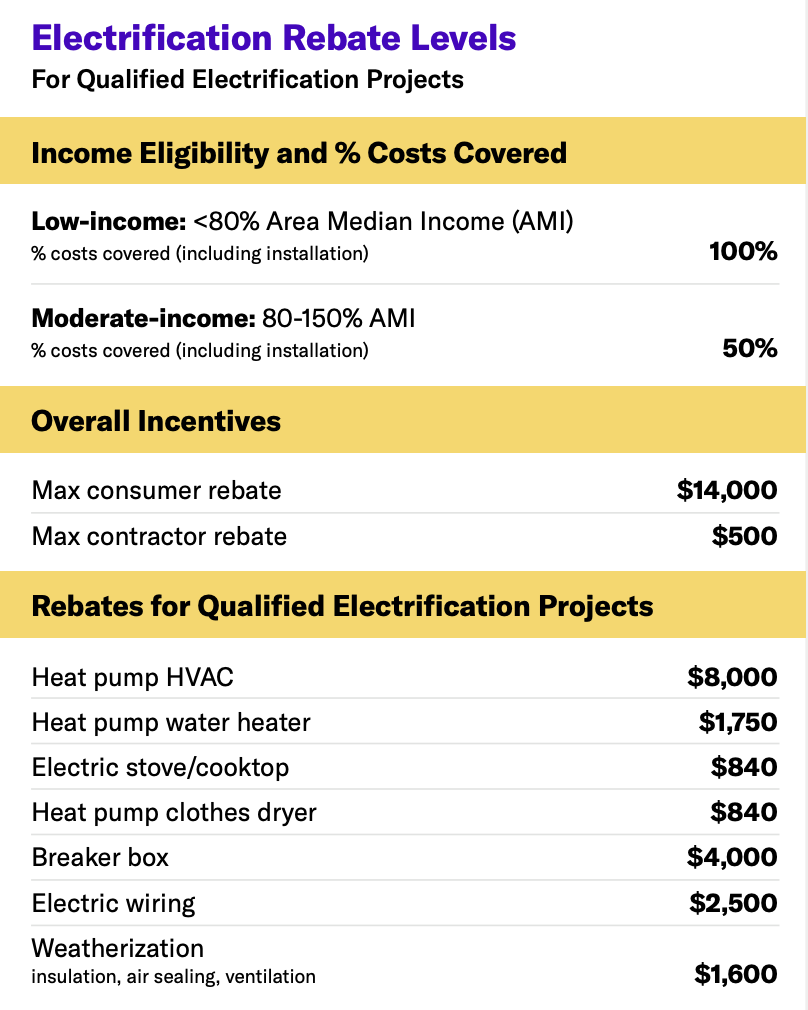
ISSUE BRIEFING:
Home Electrification Incentives
Consumers can save over $17,000 on electrifying their homes thanks to the Inflation Reduction Act.
Clear Policy Ask
As trusted messengers, elected officials should use their constituent communications channels to 1) spread awareness of federal home electrification incentives and 2) help foster a social norm around making those upgrades.
Spreading the word about home electrification incentives
The Inflation Reduction Act (IRA), a landmark climate law, is a spending bill at its core. It allocates billions of federal dollars toward important programs, but the money is only as good as the implementation of the law’s programs. Already, consumers can save thousands in tax credits for residential electrification upgrades, while billions in rebates for low- and moderate-income households will be made available later this year.
Your elected officials are the perfect messengers for spreading awareness about these opportunities due to their vast communications channels and voices of authority. Elected officials often maintain multiple communications channels to keep their constituents abreast of what they’re working on—think newsletters, social media, and local town halls. Besides simply relaying information about government programs, elected officials can take the opportunity to explain complex regulations in plain English and share real stories of neighbors electrifying their homes to spark social contagion.
Why electrification?
Converting residential buildings to all-electric dwellings means eliminating direct fossil fuel use in the home (such as gas stoves or water heaters). Combined direct emissions from residential and commercial buildings account for ~13% of emissions nationwide (you can check your state’s residential building emissions here). Fossil gas represents up to 87% of direct building emissions (or ~11% of total nationwide emissions), so replacing gas-powered appliances at their end of life is particularly effective at bringing down those numbers over time. And eliminating residential building emissions delivers huge benefits when coupled with the decarbonization of our electric grid:
Source: Rewiring America
What kinds of upgrades qualify?
The kinds of home upgrades eligible for tax credits and rebates are designed to reduce your home’s direct emissions as well as your home’s overall energy usage. Qualifying projects eliminate the sources of emissions, like replacing gas-powered clothes dryers with electric ones, and/or reduce the amount of energy used, such as making your home a more efficient consumer of electricity. Energy efficiency saves you money, but it’s also important for emissions reduction. Even when all of your home’s appliances are electric, fossil-burning power plants still supply 60% of grid electricity in the U.S.
There are a ton of electrification and efficiency upgrades that may qualify under these programs, but the big categories are appliances (heat pumps, heat pump water heaters, electric clothes dryers, electric coil or induction stoves), power generation and storage (rooftop solar, geothermal heat, home battery storage), and efficiency upgrades (electrical panels and wiring, weatherization, insulation, and annual energy audits).
How do the rebates and tax credits differ?
Tax credits, in general, are refunds on taxes owed that are claimed from the IRS during tax filing. For most tax credits, there’s a minimum income level required to maximize their benefits, since you’d need to owe those taxes in the first place. The IRA’s home electrification credits are capped at $3,200 per year in total across all upgrade categories. Some tax credits are intended for one-time upgrades, while others can be claimed year after year. (Feeling nerdy? Check out this tax credit fact sheet from Rewiring America).
Rebates are cash reimbursements for eligible purchases, used to incentivize those purchases. The IRA’s home electrification rebates will be issued by the Department of Energy to low- and moderate-income households, covering 100% and 50% of costs for those respective categories. The cool thing about these rebates is that they’ll be applied directly at the point of sale (including for installation!), so eligible households will never have to front the cost of electrification upgrades. There’s also a $500-per-project rebate for contractors who take on electrification installation work. (If this amps you up, read more about the rebates from Rewiring America).
Source: Rewiring America

Quick Frames
We (and the decision-makers we want to persuade) are each approaching the climate crisis through different lenses. Facts are facts, but it can be helpful to frame them differently to match those individual lenses. Here are some common frames that speak to different perspectives:
💡RAPID DECARBONIZATION: Residential buildings account for more than 10% of annual U.S. greenhouse gas emissions.
♥️ HUMAN HEALTH: Residential appliances that burn fossil fuels, such as gas stoves, create harmful indoor air pollution and are significant contributors to childhood asthma. Meanwhile, outdoor air pollution from residential buildings accounts for over 15,000 premature deaths every year.
✊ EQUITY AND JUSTICE: Low- and moderate-income (LMI) households bear 3x the energy burden as higher income households, while communities of color are disproportionately impacted by poor indoor air quality.
💰 COST SAVINGS: Electrifying residential buildings nationwide would save an average of almost $500 in energy costs per year, per household.
💼 JOB CREATION: Nationwide home electrification could catalyze the creation of over a million jobs in installation, manufacturing, and further down the supply chain.
STOP! You now know enough about home electrification to take action.
Recommended Actions
Want more information? Keep reading below. ⬇️
Building a Case for Home Electrification
-
The U.S. residential and commercial building stock accounts for almost a third of emissions, including 10-15% from direct fossil fuel use in heating and cooking. (The other 20% comes from electricity use, which would be eliminated by decarbonizing the power sector). Research from RMI indicates that heat pump technology has matured to the point of being more efficient than gas heat in almost every state, even in cold weather. Current heat pumps range from 2.2 to 4.5x more efficient than Energy Star gas furnaces.
-
A new study from Rare called the Climate Culture Index found that belief that other people are retrofitting and electrifying their homes is a strong predictor of their intention to do so themselves. Most people surveyed had already considered making electrification home upgrades, and at the very least, they believe others should be making those changes.
These insights suggest the need to foster a social norm about home retrofits, a goal that our elected officials have the ability to promote.
-
Because furnaces and water heaters have extremely long lifespans, every new gas heating unit sold is a 15-year missed opportunity for electric heat. Currently, over 60% of U.S. homes are still heated by fossil fuels.
Additionally, the Inflation Reduction Act is here to stay for now, but every law has the potential to be repealed, thus ending this era of unprecedented climate incentives.
The urgency of the climate crisis means we should have started replacing carbon-intensive appliances—and cutting CO2 emissions across the economy—25 years ago. Now that we’ve waited so long, our work needs to happen much more quickly, and that’s what the IRA was designed to do.
-
Research by Rewiring America found that nationwide home electrification would save a collective $37.3 billion per year in energy costs, distributed across 88% of U.S. households, including substantial savings for low- and middle-income households. That’s an average of about $500 per year, per household.
-
According to Rewiring America, residential electrification would create over 460,000 installation jobs, 80,000 manufacturing jobs, and 800,000 indirect and induced jobs nationwide.
-
Building electrification can deliver substantial benefits to both indoor and outdoor air quality. According to Rewiring America, electrifying indoor appliances would address the 42% increased risk of childhood asthma caused by gas stoves alone.
Meanwhile, it would reduce premature deaths from the outdoor air pollution caused by building emissions, which currently total over 15,000 per year in the U.S.
Sample Social Post
⬇️ Tailor this message for Twitter, Instagram, LinkedIn, Threads, Facebook, TikTok….
The federal government is subsidizing a ton of electric appliances and home energy efficiency upgrades. Did you know you might be eligible for a giant tax credit by making upgrades that will also help you save on energy costs every year? [@YOUR MAYOR, @YOUR CITY COUNCIL MEMBER, @YOUR MEMBER OF CONGRESS] please do more to spread the word to our neighbors about these amazing benefits!
Additional Policy Resources
Rewiring America: IRA Fact Sheets
Rewiring America: Electrify Everything in Your Home
Rewiring America: IRA Savings Calculator
Rewiring America: Bringing Infrastructure Home: A 50-State Report on U.S. Home Electrification
U.S. Department of Energy: Home Energy Rebate Programs





